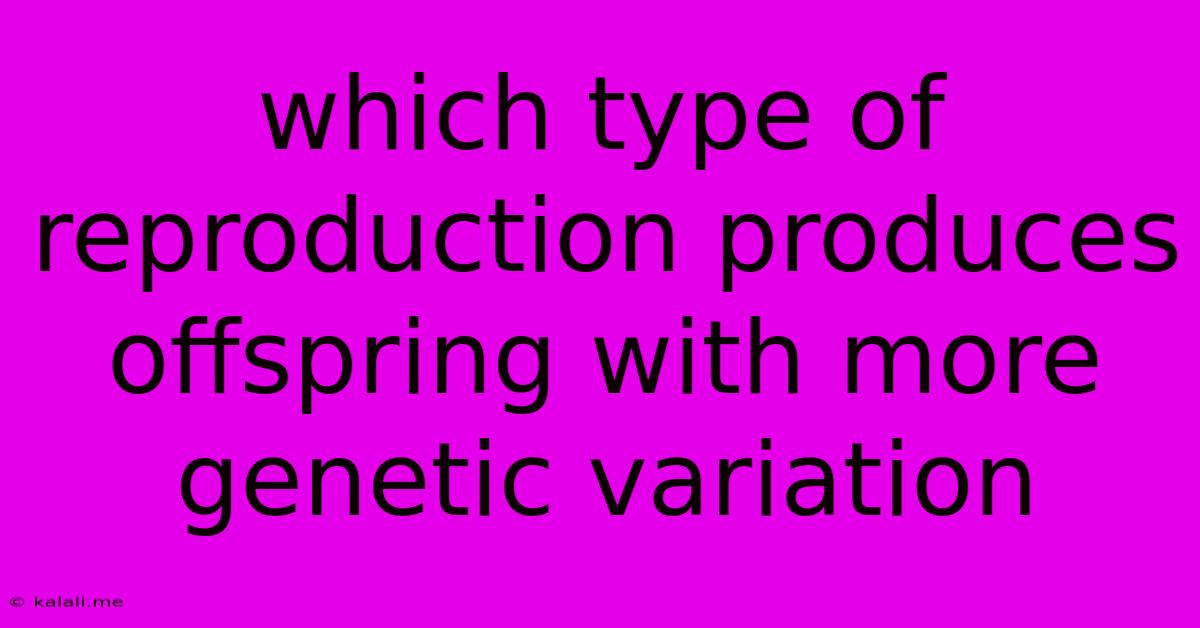Which Type Of Reproduction Produces Offspring With More Genetic Variation
Kalali
May 09, 2025 · 3 min read

Table of Contents
Which Type of Reproduction Produces Offspring with More Genetic Variation?
Meta Description: Discover which reproductive method – sexual or asexual – leads to greater genetic variation in offspring. We explore the mechanisms behind each, highlighting the advantages and disadvantages of each approach for adaptation and evolution.
Genetic variation is the cornerstone of evolution. Without it, populations would be unable to adapt to changing environments, and the process of natural selection would grind to a halt. The amount of genetic variation in offspring directly impacts a species' ability to survive and thrive. So, which type of reproduction – sexual or asexual – produces offspring with more genetic variation? The answer is clear: sexual reproduction.
Understanding Sexual Reproduction
Sexual reproduction involves the fusion of gametes (sex cells – sperm and egg) from two parents. This fusion, known as fertilization, combines the genetic material from both parents, creating a unique offspring. Several key mechanisms contribute to the high genetic variation seen in sexually reproducing organisms:
-
Independent Assortment: During meiosis (the cell division process that produces gametes), homologous chromosomes (one from each parent) line up randomly along the metaphase plate. This random alignment leads to different combinations of chromosomes in the resulting gametes.
-
Crossing Over (Recombination): Homologous chromosomes exchange segments of DNA during meiosis. This process shuffles genetic material, creating new combinations of alleles (different versions of a gene) that were not present in either parent.
-
Random Fertilization: The fusion of a sperm and egg is a random process. Given the vast number of possible gamete combinations in each parent, the probability of any two gametes uniting is astronomically low, leading to a highly unique offspring genotype.
These three mechanisms working in concert create offspring with a vastly different genetic makeup compared to their parents and to each other, leading to significant genetic diversity within a population. This diversity is crucial for adaptation to environmental changes and resistance to diseases.
Understanding Asexual Reproduction
Asexual reproduction, in contrast, involves a single parent producing offspring that are genetically identical to itself (clones). This occurs through various mechanisms, including binary fission (in bacteria), budding (in yeast), and vegetative propagation (in plants). Because there is no mixing of genetic material from two parents, the offspring inherits an exact copy of the parent's genome. This leads to:
- Low Genetic Variation: Asexual reproduction produces offspring with very little genetic variation. Any mutations that occur are the primary source of variation, and these are relatively rare events.
The Advantages and Disadvantages
While asexual reproduction is efficient and requires less energy, the lack of genetic diversity presents a significant vulnerability. If environmental conditions change, the entire population could be wiped out because all individuals are genetically identical and equally susceptible to the same threats.
Sexual reproduction, while more energy-intensive and complex, offers the critical advantage of high genetic variation. This diversity allows for natural selection to act upon a wider range of traits, increasing the chances of some individuals possessing the characteristics necessary to survive and reproduce in changing environments. This is the driving force behind adaptation and evolution.
In Conclusion
While both sexual and asexual reproduction have their roles in the biological world, sexual reproduction demonstrably produces offspring with significantly more genetic variation. This high level of genetic diversity is essential for the long-term survival and evolutionary success of a species, making it a vital aspect of life on Earth.
Latest Posts
Latest Posts
-
Is Density A Chemical Or Physical Property
May 09, 2025
-
20 Kilograms Equals How Many Pounds
May 09, 2025
-
Baking Soda Is A Compound Or Element
May 09, 2025
-
23 Degrees Celsius Converted To Fahrenheit
May 09, 2025
-
100 Is What Percent Of 250
May 09, 2025
Related Post
Thank you for visiting our website which covers about Which Type Of Reproduction Produces Offspring With More Genetic Variation . We hope the information provided has been useful to you. Feel free to contact us if you have any questions or need further assistance. See you next time and don't miss to bookmark.